Seka is a town located in the Oromia Region in southeastern Ethiopia.
Seka is a town located in the Oromia Region in southeastern Ethiopia.
It is planned that this town will receive a railway station on the new Ethiopian Railway system.

Transport in Ethiopia is overseen by the Ministry of Transport and Communications. Over the last years, the Ethiopian federal authorities have significantly increased funding for rail and road construction to build an infrastructure, that allows better economic development.
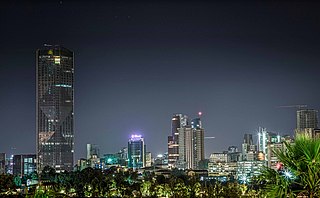
Addis Ababa is the capital and largest city of Ethiopia. In the 2007 census, the city's population was estimated to be 2,739,551 inhabitants. Addis Ababa is a highly developed and important cultural, artistic, financial and administrative center of Ethiopia. It is widely known as one of Africa's major capitals.

Massawa or Mitsiwa is a port city in the Northern Red Sea region of Eritrea, located on the Red Sea at the northern end of the Gulf of Zula beside the Dahlak Archipelago. It has been a historically important port for many centuries. Massawa has been ruled or occupied by a succession of polities during its history, including the Kingdom of Aksum, the Ethiopian Empire, the Ottoman Empire and the Kingdom of Italy.
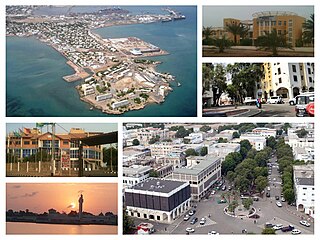
Djibouti is the capital of Djibouti. It is located in the coastal Djibouti Region on the Gulf of Tadjoura.

Weldiya or Woldia is a town, woreda, and capital of the North Wollo Zone in the Amhara Region in northern Ethiopia. It has an elevation of 2112 meters above sea level and is surrounded by Guba Lafto woreda. Both are located north of Dessie and southeast of Lalibela.

Dire Dawa is a city in eastern Ethiopia near the Somali Region and Oromo border and one of two chartered cities in Ethiopia. Dire Dawa alongside present-day Sitti Zone were a part of the Dire Dawa autonomous region of the Somali Region stipulated in the 1987 Ethiopian Constitution until 1993 when it was split by the federal government into a separately administered chartered city.
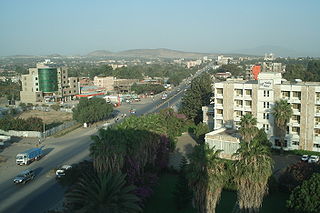
Adama, formerly Nazreth, is a one of the cities of Oromia Region of Ethiopia. Located in the East Shewa Zone 99 km (62 mi) southeast of the capital, Addis Ababa, the city sits between the base of an escarpment to the west, and the Great Rift Valley to the east.
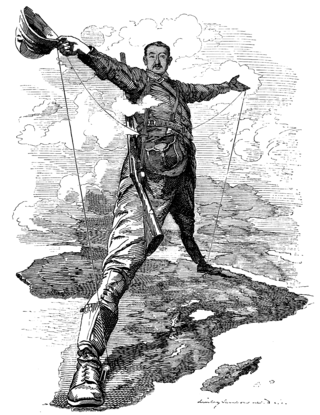
The Cape to Cairo Railway was an unfinished project to create a railway line crossing from southern to northern Africa. It would have been the largest, and most important, railway of the continent. It was planned as a link between Cape Town in South Africa and Port Said in Egypt.

Kombolcha is a town and district in north-central Ethiopia. Located in the Debub Wollo Zone of the Amhara Region, it has a latitude and longitude of 11°5′N39°44′E with an elevation between 1842 and 1915 meters above sea level. Some guide books describe Kombolcha as the twin town of Dessie which lies some 12 kilometres (7.5 mi) to the northwest.

Awash Subah is a market town in central Ethiopia. Located in Administrative Zone 3 of the Afar Region, above a gorge on the Awash River, after which the town is named, the town lies on the Addis Ababa–Djibouti Railway, which crosses the gorge by a bridge there. It is the largest settlement in Awash Fentale woreda.
Dilla is a market town and separate woreda in southern Ethiopia. The administrative center of the Gedeo Zone in the former Southern Nations, Nationalities, and Peoples Region (SNNPR) now it is South Ethiopia Regional State (SER), it is located on the main road from Addis Ababa to Nairobi. The town has a longitude and latitude of 6°24′30″N38°18′30″E, with an elevation of 1570 meters above sea level. It was part of Wenago woreda and is currently surrounded by Dilla Zuria woreda.
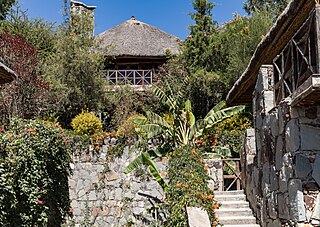
Bishoftu is a town in central Ethiopia. Located in the East Shewa Zone of the Oromia Region, it sits at an elevation of 1,920 metres (6,300 ft). It was formerly known as Debre Zeyit. However, since the late 1990s, it has been officially known by the Oromo name, Bishoftu from bishaanooftuu, which was its name until 1955. The town serves as the primary airbase of the Ethiopian Air Force.
Rail transport in Ethiopia is done within the National Railway Network of Ethiopia, which currently consists of three electrified standard gauge railway lines: the Addis Ababa–Djibouti Railway, the Awash–Weldiya Railway and the Weldiya–Mekelle Railway. Other lines are still in the planning phase. There is also an urban light rail system in the country's capital, the Addis Ababa Light Rail.
Badessa is a town and separate Aanaa in eastern Ethiopia. Located in the West Hararghe Zone of the Oromia Region, at the base of a spur of the Chercher Mountains 40 km south of the Addis Ababa - Djibouti Railway and 65 km east of Awash, this town has a latitude and longitude of 8°54′N40°47′E with an elevation of 1761 m above sea level.

Current railway stations in Ethiopia are served by standard gauge railways of the National Railway Network of Ethiopia which is mostly under construction, except the Addis Ababa–Djibouti Railway. Other stations were built for the in 2018 still operating metre gauge Ethio-Djibouti Railways, although this railway has officially been superseded by the new Addis Ababa-Djibouti Railway.

The Ethio-Djibouti Railway is a metre gauge railway in the Horn of Africa that once connected Addis Ababa to the port city of Djibouti. The operating company was also known as the Ethio-Djibouti Railways. The railway was built in 1894–1917 to connect the Ethiopian capital city to French Somaliland. During early operations, it provided landlocked Ethiopia with its only access to the sea. After World War II, the railway progressively fell into a state of disrepair due to competition from road transport.
Bike is a town in central Ethiopia of the Somali Region in the Sitti Zone. It is located 72 km west of Shinile. The town is located on the main railway between Djibouti City and Addis Ababa.

The Cairo–Cape Town Highway is Trans-African Highway 4 in the transcontinental road network being developed by the United Nations Economic Commission for Africa (UNECA), the African Development Bank (AfDB), and the African Union. The route has a length of 10,228 km (6,355 mi) and links Cairo in Egypt to Cape Town in South Africa.
Hadhagaala or Adigala is a small town in north-eastern Ethiopia. It is served by a station on the narrow gauge Ethio-Djibouti Railways. The railway reached Adigale in 1902. The station is about 100 km inside Ethiopia from the border with Djibouti. The community living in the city mostly trades in the train

The Addis Ababa–Djibouti Railway is a standard gauge international railway that serves as the backbone of the new Ethiopian National Railway Network. The railway was inaugurated by Prime Minister Hailemariam Desalegn on January 1, 2018. It provides landlocked Ethiopia with access to the sea, linking Ethiopia's capital of Addis Ababa with Djibouti and its Port of Doraleh. More than 95% of Ethiopia's trade passes through Djibouti, accounting for 70% of the activity at the Port of Djibouti.